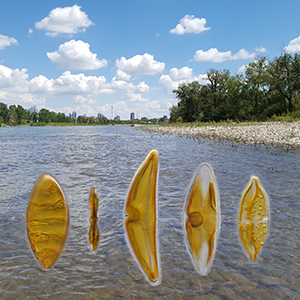Exploring diatom diversity through cultures - a case study from the Bow River, Canada

Accepted: 18 November 2022
HTML: 11
All claims expressed in this article are solely those of the authors and do not necessarily represent those of their affiliated organizations, or those of the publisher, the editors and the reviewers. Any product that may be evaluated in this article or claim that may be made by its manufacturer is not guaranteed or endorsed by the publisher.
Authors
Diatom cultures can help answer taxonomic, biogeographic and ecological questions on a local and global scale. Unialgal cultures are derived from a single cell and provide abundant material for morphological and molecular analyses. The link between the historic morphological species concept and the molecular data is becoming increasingly important with the use of eDNA metabarcoding. Additionally, cultures provide insights into the life cycle of diatoms and thereby complement taxonomy and species ecology. In this study, we present an approach to extract benthic diatoms from an environmental sample to generate unialgal cultures. We explored diatom diversity in preserved assemblages and by culturing as many different taxa as possible from benthic freshwater samples taken on the same day from the Bow River in Calgary, Canada. With both methods we found a total of 221 different benthic diatom taxa, of which 182 were identified in the preserved diatom assemblages. Interestingly, an additional 39 taxa only appeared in the cultures. In total 129 strains were cultivated representing 71 different taxa. This study includes pictures of living cells demonstrating the additional merits of unialgal cultures, as they provide information on plastid details, auxospores and endosymbionts. Both, the identification of the diatom assemblages and the generation and identification of strains provide the foundation for additional water quality assessment tools, taxonomic insights and molecular references libraries.
Edited by
Francesca Bona, Department of Life Sciences and Systems Biology, University of Turin, ItalySupporting Agencies
Verein der Freunde des Botanischen Gartens und Botanischen Museums Berlin Dahlem e.V. , Federal Ministry of Education and Research (German Barcode of Life 2 Diatoms, GBOL2)How to Cite

This work is licensed under a Creative Commons Attribution-NonCommercial 4.0 International License.
Similar Articles
- Piotr Klimaszyk, Ryszard Piotrowicz, Piotr Rzymski, Changes in physico-chemical conditions and macrophyte abundance in a shallow soft-water lake mediated by a Great Cormorant roosting colony , Journal of Limnology: Vol. 74 No. 1 (2015)
- Nikolai M. Korovchinsky, A new species of Diaphanosoma Fischer, 1850 (Crustacea: Branchiopoda: Sididae) inhabits lakes of the western United States , Journal of Limnology: Vol. 75 No. 1 (2016)
- Giuseppe MORABITO, Delio RUGGIU, Pierisa PANZANI, Trends of phytoplankton characteristics and their communities in pre- and post-liming time in Lake Orta (1984-1998) , Journal of Limnology: Vol. 60 No. 1 (2001)
- Yury KAMENIR, Giuseppe MORABITO, Lago Maggiore oligotrophication as seen from the long-term evolution of its phytoplankton taxonomic size structure , Journal of Limnology: Vol. 68 No. 1 (2009)
- Giuseppe MORABITO, Waleed HAMZA, Delio RUGGIU, Carbon assimilation and phytoplankton growth rates across the trophic spectrum: an application of the chlorophyll labelling technique , Journal of Limnology: Vol. 63 No. 1 (2004)
- Eliana A. Beltrán-Pardo, Ingemar Jönsson, Andrzej Wojcik, Siamak Haghdoost, Rosa María Bermúdez Cruz, Jaime E. Bernal Villegas, Sequence analysis of the DNA-repair gene rad51 in the tardigrades Milnesium cf. tardigradum, Hypsibius dujardini and Macrobiotus cf. harmsworthi , Journal of Limnology: Vol. 72 No. s1 (2013): 12th International Symposium on Tardigrada
- Fernando W. Bernal-Brooks, José J. Sánchez Chávez, Luis Bravo Inclán, Rubén Hernández Morales, Ana K. Martínez Cano, Owen T. Lind, Laura Dávalos-Lind, The algal growth-limiting nutrient of lakes located at Mexico’s Mesa Central , Journal of Limnology: Vol. 75 No. s1 (2016): Proceedings of the 6th National Congress of Limnology
- Juliana V. Rangel, Rosângela E.S. Araújo, Cinthia G. Casotti, Larissa C. Costa, Walace P. Kiffer Jr., Marcelo S. Moretti, Assessing the role of canopy cover on the colonization of phytotelmata by aquatic invertebrates: an experiment with the tank-bromeliad Aechmea lingulata , Journal of Limnology: Vol. 76 No. 2 (2017)
- Luc De Meester, Jelena Pantel, Eco-evolutionary dynamics in freshwater systems , Journal of Limnology: Vol. 73 No. s1 (2014): Limnology in the 21st Century: celebrating 75 years of ecological research in Pallanza
- Monika Tarkowska-Kukuryk, Wojciech Pęczuła, Tomasz Mieczan, Grazing affects periphytic algal biomass in the periphyton-macrophyte relationship independently of the substrate type and nutrient status , Journal of Limnology: Vol. 79 No. 2 (2020)
<< < 51 52 53 54 55 56 57 58 59 60 > >>
You may also start an advanced similarity search for this article.
-
Katherina Schimani, Nélida Abarca, Oliver Skibbe, Heba Mohamad, Regine Jahn, Wolf-Henning Kusber, Gabriela Laura Campana, Jonas ZimmermannMetabarcoding and Metagenomics : 2023

 https://doi.org/10.4081/jlimnol.2022.2095
https://doi.org/10.4081/jlimnol.2022.2095





